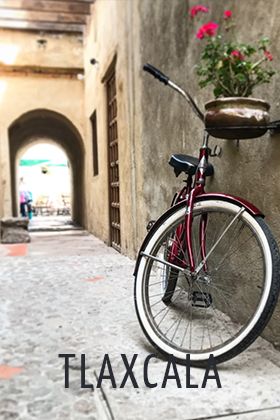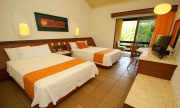About Cuernavaca
by: Travel by México

About Cuernavaca
by: Travel by México
Cuernavaca, capital of the state of Morelos, is one of the most ancient cities in México and is located 60 kilometres from México City.
There are historical references that take us back to the year 1200 B.C., to what could be considered the first human settlement of the region. We are talking about the fifth nahualteca tribe founded in the Cuauhnáhuac region, luminous valley to which they descended from the Ajusco Mountain Range at the end of their pilgrimage from up north, place serving in the future as capital of the estate. With the arrival of the Spaniards the name Cuauhnáhuac would change into Cuernavaca, becoming later on into Hernán Cortés summer holiday resort, as well as a favorite place for many celebrities who have found here a perfect location to live permanently.
Cuernavaca possesses an accidental city planning, with evident immoderate growth during recent decades; the main avenues are narrow, the streets twirl into pronounced slopes, intertwining occasionally with no order whatsoever. Well then, what exactly has attracted the attention of so many to this city?
Most appear to coincide in the affirmation that it has been the weather of the region, to such a degree that Cuernavaca has been known as “The City of the Eternal Spring”. And it’s been precisely this heavenly fame that has converted it into a “weekend” city, a city of repose where there are many properties that belong, mainly, to people that live in México City and who come here in order to get away from the hustle and bustle of the great capital. In the surrounding area of the Boulevard Juárez or the street of Galeana located downtown, there are various high walls surrounding big houses of lineage; grand and luxurious residence areas like Vista Hermosa or the Golf Club Tabachines, residencial compounds that follow one after the other in colonies such as Delicias, Rancho Cortés or Acapantzingo. Actors, embassadors, business men and all sorts of personalities have owned or own a property in Cuernavaca.
Nevertheless there is another aspect that has recently characterized this city: foreign students, coming mainly from the US, arrive every year to attend to summer courses where spanish is taught, giving rise to a series of schools and boarding houses which depend mainly on this student sector that is constantly growing. But of course, Cuernavaca offers many other aspects of tourist and cultural interest.
What is known today as the Palace of Cortés, elegant building located downtown of the city. lodges the Regional Museum of Cuauhnáhuac since 1974. There is no doubt that we are dealing here with one of the first constructions set about in Mexico after the fall of Tenochtitlán, begun in 1526. And besides counting with 3 murals realized by the famous painter Diego Rivera, at the entrance of the building one may observe the prehispanic remains of a tlahuica construction, as well as 3 monoliths and inscriptions with a meaning that envelops the testimony of a native past that has been lost in time.
Before the Palace of Cortés is the main plaza of the city, where an enormous statue of the independence heroe, don José María Morelos is edified, as well as the building of the Government Palace, built between 1955 and 1969 and consisting of stone, quarry and tezontle. Very close from there is the Plazuela del Zacate, a small cobble stone street that has been recently transformed since diverse bohemian type of bars and restaurants have opened their doors to the public. All of them count with musicians who sing all sorts of tunes along the rythm of the guitar, followed by the customers who sing along while enjoying a beer either indoors or at a sunshaded table outdoors. Reason why the Plazuela has become one of the most frequented meeting places of the city.
A few steps away one may find the Cathedral of Cuernavaca, built over a native teocalli in 1526 by don Francisco Becerra. This building possesses certain qualities that differentiates it from other religious buildings of the country. It has only one tower and is part of a complex of religious buildings, besides the fact that it wasn’t originally built to serve as episcopal residence. In 1891 it was ascended to the rank of Cathedral.
Before the cathedral, crossing the Morelos Avenue, is one of the most characteristic places of Cuernavaca: the Borda Garden, built in the XVIIIth century as retirement home of the famous miner of Taxco Don José de la Borda, who strangely, never got to live in it. As time went by, the place served as inn, public office, diligence post, home of the Emperor Maximiliano and his wife Carlota, etc.. Among many others, it would also become a botanical garden and large vegetable garden where plants from all over the world would be brought in great quantities in order to be adapted to the climate of the region. As a matter of fact, it was there where the first mango trees that ever existed in Mexico were cultivated.
Now the Borda Garden opens its doors as museum, being one of the most valuable cultural centers of the city. Another place of great interest is the building acquired in 1961 by the artist and collector, Robert Brady, serving too as museum. Exhibited in this place is a vast collection of masterpieces acquired personally by Brady in Africa, India and Mideast, as well as paintings by Frida Kahlo, Rufino Tamayo, Miguel Covarrubias among many others.
However, in Cuernavaca also exists a link with the remote past of Mexico; an ancient ceremonial center that during centuries remained hidden under a small hill was unearthed when accidentally hit by a cannon in 1912 during the Mexican Revolution. We are talking about Teopanzolco, “the old temple” in náhuatl tongue, which consisted of 12 monuments, two of them circular.



















